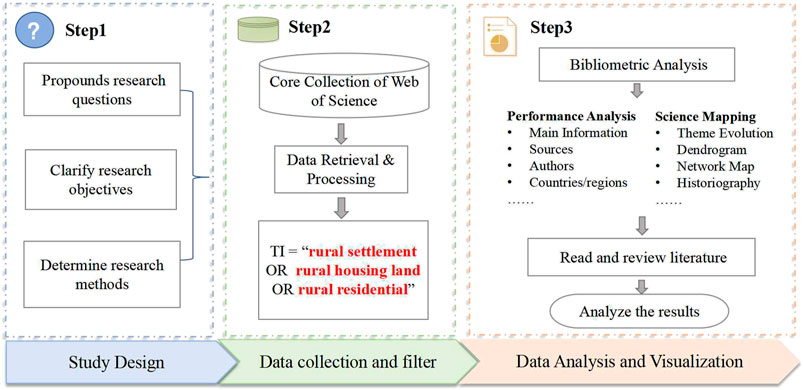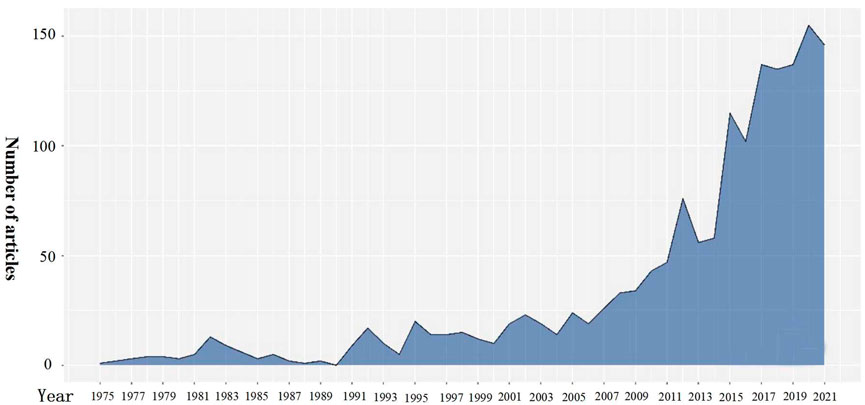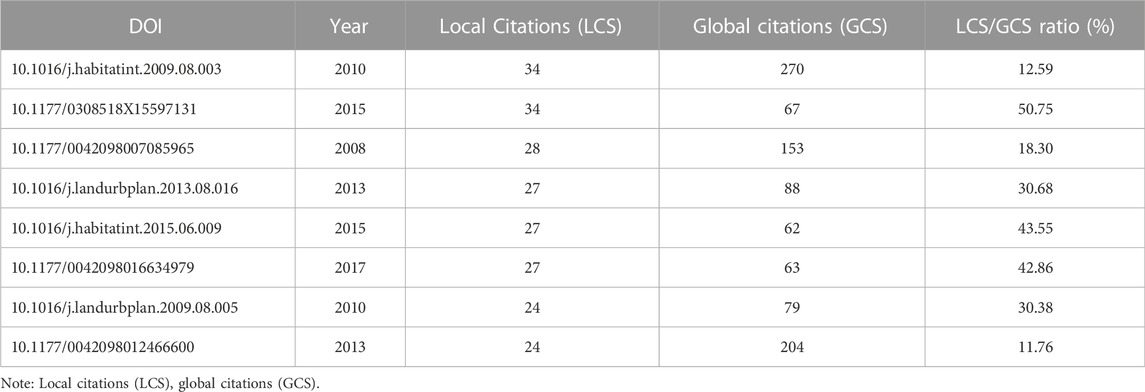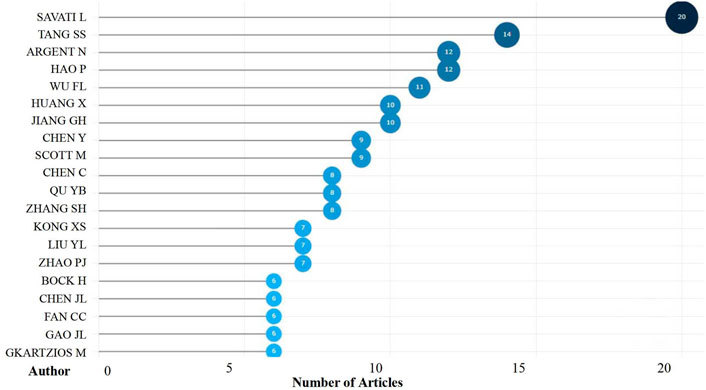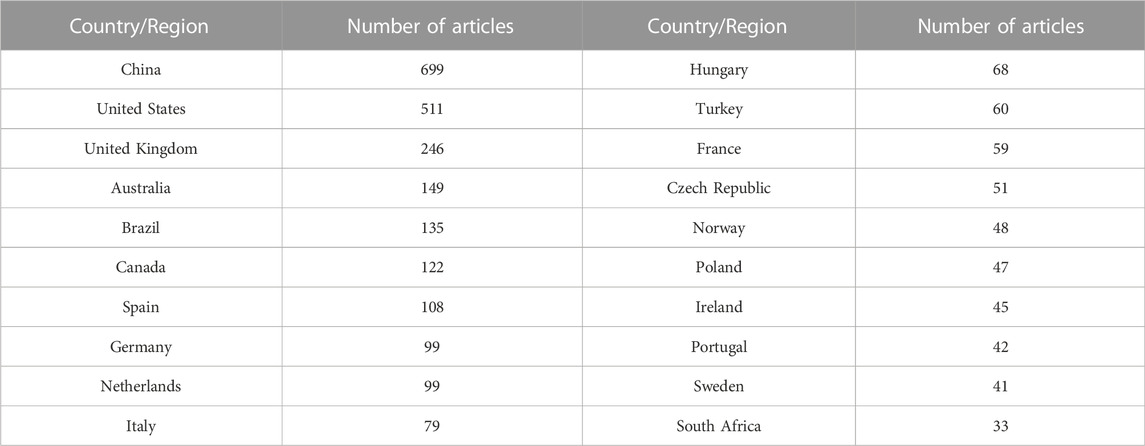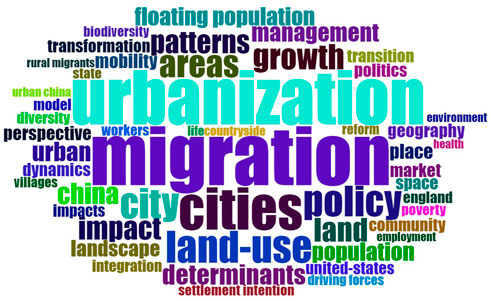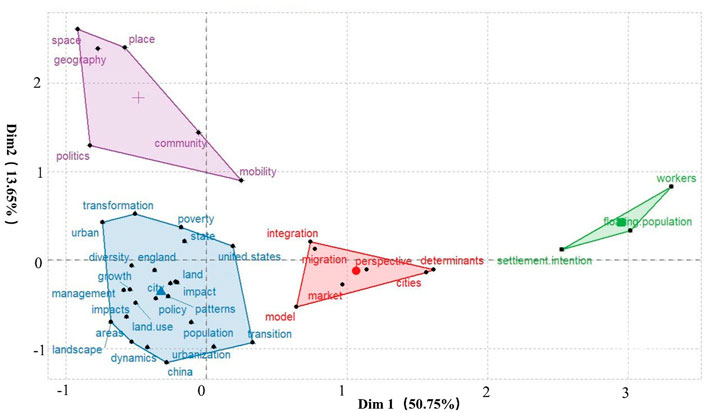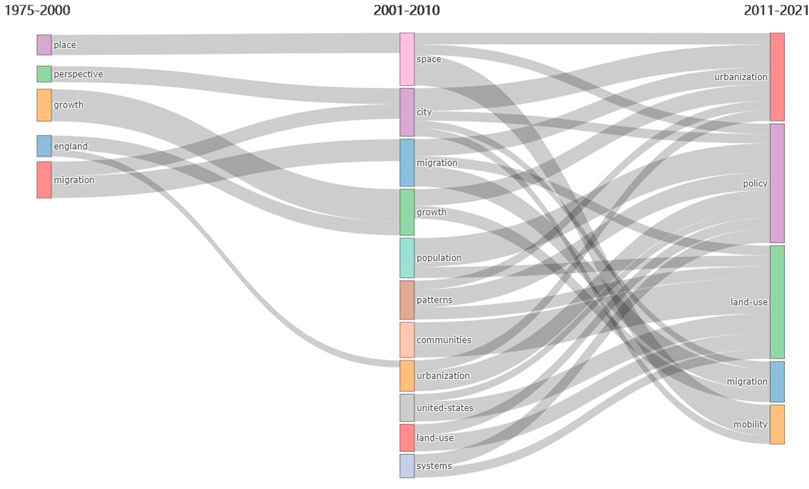- 1School of Earth Science and Resources, Chang’an University, Xi’an, China
- 2Key Laboratory of Land Surface Pattern and Simulation, Institute of Geographic Sciences and Natural Resources Research, Chinese Academy of Sciences, Beijing, China
- 3Hebei Collaborative Innovation Center for Urban-rural Integration development, Shijiazhuang, China
Rural settlements are important rural land use types, and rural transformation and reconstruction are global issues in the process of urbanization. Research on rural settlements has been performed form different perspectives. In this paper, we took articles on rural settlements published in the core collection of Web of Science from 1973 to 2021 as the object of measurement analysis. Literature induction was used to determine the research progress, using the Bibliometrix measurement software. We also summarized the number of published papers, authors, research institutions and cooperative relationships, and keywords and investigated the theme evolution in the field of rural settlements. The following main results were obtained: 1) the number of articles related to rural settlements published was 1,703; the time from 1973 to 2021 can be roughly divided into three evolutionary stages: the initial stage (1973–1990), the development stage (1991–2010), and the high-yield stage (2011–2021). The number of articles published increased sharply after 2011, indicating that this research field received increased attention. 2) China and the United States published the largest number of articles in this field, followed by Australia. 3) In recent years, “Immigration,” urbanization,” “Land use,” and “Floating population” were the most frequent keywords. Clustering analysis revealed four research. 4) Research in rural settlement areas changed largely over time; currently, in the context of urbanization, scientists focus on the renovation of rural settlements.
1 Introduction
As the main rural population settlement type and the spatial unit of rural population activities, the rural settlement plays a crucial role in rural economy and society (Phillips, 1998). Research on the coordinated development of regional agriculture and rural areas and the balanced development of industry and urban areas has become an important field in geographic development (Deng et al., 2021). Rural settlements, as the core of rural human and land relations, have attracted great attention in recent years as the main areas of rural peoples’ activities. The main contents of the theoretical system of studying rural settlements include rural geography, rural sociology, rural economics, and rural ecology (Long et al., 2020).
With the rapid development of the economy and society in rural areas, the distribution characteristics and spatial structure of rural settlements are constantly evolving, resulting in a scattered layout, and lack of planning; in some cases, the cultivated land area is threatened (Whatmore, 1993; Zhang et al., 2014). Politicians and scientists are therefore highly concerned about the further development of this phenomenon, and rural settlement land use has been studied extensively (Sevenant and Antrop, 2007). Urbanization has intensified the competition between rural settlements and other land use types. For example, the expansion of rural settlements frequently results in the occupation of surrounding farmland (Bibby, 2009), causes the degradation of forest land and grassland area (Kohler et al., 2015), and negatively impacts wetlands (Brady and Flather, 1994). At the same time, with the increasing recognition of the importance of these issues at a global level, the spatio-temporal evolution of rural settlements has been investigated extensively. Relevant studies mainly focused on the evolution and development characteristics and mechanisms of rural settlements as well as the impacts of socio-economic and political systems. Current research hotspots are the driving factors of rural settlement changes, location selection, layout optimization, landscape and ecological environment protection, and the potential analysis and sorting mode selection of rural settlement consolidation (Huang et al., 2020; Li et al., 2021).
Globally, studies on rural settlements mainly consider their formation, location, function, and land use types (Kiss, 2000; Thorsen and Ubøe, 2002; Nepal, 2007; Song and Deng, 2017), with emphasis on the methods of various disciplines and the influences of cultural and socio-economic factors on rural settlement development (Song and Pijanowski, 2014). For example, Vesterby and Kru Pa investigated the changes in rural settlement use and urban construction land use in the United States from 1980 to 1997, whereas Ruda found that agricultural industrialization resulted in a trend toward concentrated residences. Over time, the scale of new villages gradually expanded, whereas numerous small villages were abandoned and gradually disappeared, leading to changes in the layout and structure of regional rural settlements.
Since the 21st century, studies on land use/cover change (LUCC) have been strongly promoted internationally. In addition, the implementation of the Global Land Plan (GLP) project and various environmental issues have received widespread attention, and research on the spatial and temporal patterns of rural settlements, evolution simulation, and other aspects has become more comprehensive. In China, research on rural settlements started in the 1960s, mainly focusing on architecture. In the 1990s, China began to carry out research on traditional residential culture from the perspective of history and folklore (Whatmore, 1993; Li and Hu, 2019), followed by the quantitative research and spatial analysis of rural settlements in the 21st century. In recent years, important achievements have been made in the aspects of rural residential spatial distribution (Guo et al., 2020; Jiang et al., 2022; Sun et al., 2022), residential spatial pattern evolution (Dong and Xu, 2020; Shi et al., 2022), residential hollowing because of the rural population outflow (Sun et al., 2011; Guo et al., 2022), and the consolidation of rural settlements (Qu et al., 2019). In the context of global urbanization, rural settlements face drastic differentiation and restructuring, facilitating rural transformation and development.
Bibliometry is a method of quantitative literature analysis in a certain field with the help of mathematics and statistical tools. Visualization tools are combined to explore the research subjects, objects, themes within a given field and to analyze their interrelationships and influences (Aria and Cuccurullo, 2017). The field of rural settlements has obvious cross-disciplinary characteristics, and this review focuses on the qualitative summary of existing research results. However, a single summary cannot sufficiently evaluate the development process and trend of the research field from a macro-perspective. Generally, research results can be summarized using data mining, network analysis, scientific measurement, and mapping. In the software tools for bibliometric analysis, BibExcel tool cannot realize data visualization. Although CiteSpace has a strong visualization ability and unique advantages in keyword collinear analysis, its operation is complex. The operation of VOSviewer is simpler, but its data filtering and visualization level are limited. The Biblimetrix tool is based on the R language for statistical data analysis and has the advantage of rapid visualization. We therefore adopted this tool to quantify articles in the field of rural settlements from 1973 to 2021. Precisely, we analyzed the changes in the number of articles over time, the historical reference relationship of the article, the distribution of the author and its national/institutions, the number of published documents, and the distribution of high-frequency keywords. The following questions are addressed in this study:
(1) How are the relevant research keywords in the field of rural settlements clustered?
(2) Which countries have cooperated in rural settlement research?
(3) What is the trend of the article citation history in the field of rural settlements?
(4) What is the focus of future research in the field of rural settlements?
2 Research methods and data sources
2.1 Data sources
Web of Science is the most disciplinary comprehensive academic information resource in the world, including more than 12,000 core academic journals in various fields such as natural science, social science, arts, and humanities, reflecting the mutual relationship among different documents. We took the core collection in the scientific database Web as the data source and searched the journals using the advanced retrieval function. The Web of Science category was limited to “geography,” “urban research,” and “regional urban planning,” and the search term was “rural settlements,” using the so-called Topic Subject (TS) method. Considering the differences in different wording habits, the search was carried out with the search formula “TS = (rural settlement OR rural housing land OR rural residential).” The document type was limited to “articles” published from 1973 to 2021, spanning approximately 50 years. Overall, 1,703 articles in the field of rural settlements were obtained.
2.2 Research methods
Bibliometric analysis is increasingly used in academia to obtain quantitative results in the development of specific (sub-) areas of scientific inquiry. By visualizing various indicators containing quantitative information for a given field, scientific measurement mapping allows to obtain a deeper insight and is therefore a useful approach in ever-changing science. This paper used the R Bibliometrix tool to study the field of rural settlements (Du and King, 2018), targeting 1,703 research articles published from 1973 to 2021.
A Bibtex file was created using the Bibliometrix quantitative method, along with data analysis and visual expression (Figure 1). The first step was to develop the research design, establish the research questions, clarify the research objectives, and determine the research methods. The second step was data collection and filtering. Based on the Web of Science™ core collection, the literature was searched for publications in the field of rural settlements, the results were screened, and irrelevant articles were removed. The third step was data analysis. First, we imported the data into Bibliometrix for analysis, including information analysis and scientific mapping, and then analyzed and visually expressed the research subjects (such as authors, journals, institutions). Subsequently, we carefully read the retrieved articles and discussed and analyzed the research hotspots and frontiers via keywords.
3 Results
3.1 Quantitative statistics and article source analysis
3.1.1 Annual change analysis of article quantity
The changes in the number of articles over time can reflect the general trend of the overall development of the research field. According to the time series analysis of the distribution trend of the annual number of articles published regarding rural settlements, the average annual growth rate was 11.44% (Figure 2). The number of articles published in the field of rural settlements could be divided into three stages: initial stage, development stage, and high-yield stage. The initial stage lasted from 1973 to 1990, with a small number of publications, indicating that the field of rural settlements received less attention. During this stage, studies mainly focused on the qualitative description of the definition, formation process, and development history of rural residential areas (Lewis and Mrara, 1986; Hingley, 2004). Although the number of research articles was small, the discussion about the concept and theoretical framework has laid a foundation for subsequent research. From 1991 to 2010, the number of published articles increased slowly, indicating that this research field attracted more attention; however, the annual number of published articles still did not exceed 50. During this period, with the development of the rural economy and an increasing awareness about environmental issues (Whatmore, 1993), scientists started to study the distribution characteristics and influencing factors of rural settlements, and relevant research gradually became more diverse. The number of publications increased exponentially from 2011 to 2021, reaching 146 publications in 2021, which is about three times higher than that in 2011. With the continuous broadening of the research perspective, results regarding the evolution and development characteristics of rural settlements as well as the impacts of social economy and the political system on changes in rural settlements were obtained (Mann, 2009; Bittner and Sofer, 2013; Yang et al., 2016).
3.1.2 Analysis of the article sources
The study of rural settlements includes numerous disciplines such as economy, environment, agricultural engineering, and architectural science. International papers on rural settlement research were mainly published in English-speaking journals related to human settlement and rural-urban research, such as Habitat International, Journal of Rural Studies, and Landscape and Urban Planning, among which Habitat International has the largest number of papers, 114 in total (Table 1). Articles in journals related to rural and urban studies were the most cited ones, such as those in the Journal of Rural Studies with 1,738 citations, Urban Studies with 1,364 citations, and Landscape and Urban Planning with 1,304 citations.
Regarding the cumulative number of articles from different journals, Landscape and Urban Planning published the most articles from 1973 to 2021. After 2018, the growth rate of articles published by Habitat International and Journal of Rural Studies surpassed that of Landscape and Urban Planning. At the same time, the two journals Cities and Population Space and Place also published considerably more articles compared to 2010. This indicates a substantial increase in the degree of attention in the past 10 years (Figure 3). From the perspective of the research topics of articles published in different types of journals, we summarized the differences in the development of rural settlements in different fields in the past 50 years. Articles published by Habitat International mostly focused on the suitability assessment of the rural residential distribution and regional classification, whereas Landscape and Urban Planning and Cities mainly published articles investigating the impacts of urbanization on rural settlements and landscapes. Articles published in the Journal of Rural Studies, Applied Geography, and other journals generally had a wider research perspective, such as the evolution of rural settlement models, the willingness of farmers to relocate, and the architectural characteristics of rural settlements.

FIGURE 3. Time dynamics of publication volume of different journals in the field of rural settlements.
3.2 Historical citation analysis of rural settlement research
The numbers of citations and downloads are of large interest for academic journals and readers. When a publication is widely cited or heavily downloaded, this reflects the influence and academic level of this publication, at least to some extent. Statistical analysis of the citation volume and downloads could reveal a hot topic, important development direction, and trends in a given field. We used the “Historiography” module of Bibliometrix to visualize the historical citations in the field of rural settlements, and 20 nodes were selected to find classical studies in this field.
We used the indicators Global Citations (GCS) and Local Citations (LCS) to analyze the degree of attention and influence of classical studies. Whilst LCS is a reference in the downloaded paper dataset, GSC represents a reference in the scientific core set database. Among the studies on rural settlements published from 1973 to 2021, the most frequently cited article was one published by Yansui Liu, a researcher from the Chinese Academy of Sciences, in Habitat International in 2010 (Liu et al., 2010), with 270 international and 34 national citations (Table 2), reflecting its research and reference value. Relevant institutions and researchers paid considerable attention to the issue of rural settlements, and most of the research results were published in high-ranking journals.
The field of rural settlement research featured many classical articles from 1973 to 2021. An article published in the Journal of Rural Studies in 1988 showed that against the background of the reduction of the rural population in Japan after the First World War, the country explored how to solve the social problem of population decline in remote rural areas by implementing the planned relocation scheme of rural settlements. Hao and Tang (2015) published an article in Environment and Planning in 2015, with the highest local citation frequency of 39 times. The authors showed that the arable land and house share of rural residents have the greatest impacts on the willingness of rural residents to relocate. At the same time, the gap between rich and poor and the intergenerational differences are also important reasons for relocating. Given the pressure excised by urban areas, the mode, driving force, and policies of rural settlements have also been largely investigated (Song et al., 2008; Tan and Li, 2013), along with the factors that impact the willingness of rural residents to relocate (Tang and Feng, 2015; Liu et al., 2017a). The most frequently cited articles were mainly published around 2010, indicating that at this time, many important achievements were made in research on rural settlements.
3.3 Analysis of key researchers and institutions
3.3.1 Researcher analysis
The data set used in this study involved 2,541 authors, among which Salvatil L, Shuangshuang Tang, and Argent N were the top three ones, with 20, 14, and 12 papers published, respectively (Figure 4). The largest number of articles was published by Salvati L, with a total of 135 citations, demonstrating the high quality and great impact of publications from this author. Salvati L’s most frequently cited paper appeared in 2016, with 28 citations (Figure 5). In 2012, this author published an article in Landscape and Urban Planning, analyzing the impacts of urban expansion models at different stages on the use of rural land. Shuangshuang Tang’s most frequently cited paper, published in Habitat International, also appeared in 2016. The authors conducted a field survey in the suburbs of Nanjing, China, in 2016, to investigate the land transfer and the willingness of rural residents to relocate, showing that abandoning farmland and housing is determined by different factors. The authors reported that villagers are largely opposed to the existing land conversion policy. Because the willingness to give up original land and settle in another region is jointly determined by socio-economic, local culture, future development prospects, and other factors, only considering the compensation scheme is not sufficient (Salvati et al., 2012). McManus et al., 2012. conducted field research in the state of New South Wales, Australia; based on a collection of farmers’ intentions to relocate, the authors proposed a future reflection on how to respond to the declining population trend in rural areas. In this study, the importance of increasing rural resilience in the face of economic and environmental challenges is emphasized.
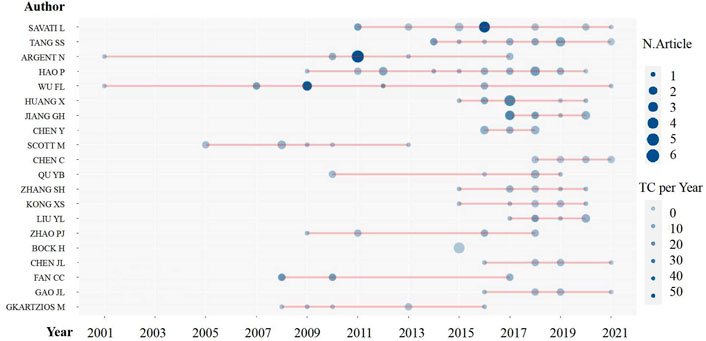
FIGURE 5. Authors’ Production during 2001–2021 in the Field of Rural Settlements. Note: N. Article is the number of articles; TC per Year is the total number of citations per year by the author.
Considering the change in the number of publications over time, we analyzed the timeline of the authors’ output in a given field (Figure 5). Wu FL is the author with the longest research period in the field of rural settlements, with articles published from 2001 to 2021. In 2010, the authors published four articles, with an average annual citation rate of 44.8. His most cited article, which presents a novel stochastic CA model to analyze urban-rural land conversion in Guangzhou, China, has 407 citations. Jiang GH started his research on rural settlements late but has a high number of publications and citations. The author published research results on rural land use transition, rural residential land use in suburban areas, and sustainable rural development. After 2015, Huang X, Zhang SH, and many other authors started to focus on the field of rural settlements, maintaining a steady publication output. It goes without saying that the number of articles is not proportional to the number of citations. Although the number of articles on rural settlement research continues to increase, classical highly cited articles are still scarce. In the future, more attention should therefore be paid to the publication of high-level articles.
3.3.2 Major research institutions and cooperations
The distribution characteristics of the main study countries/regions reflected the influences of different countries/regions on research in the field of rural settlements and provided the conditions for the different degrees of influence in further development. The top 10 countries in terms of the number of articles published were China, the United States, the United Kingdom, Australia, Brazil, Canada, Spain, Germany, the Netherlands, and Italy, mainly in Asia, Europe, and Oceania (Table 3). The number of articles published by China and the United States was considerably higher than that of other countries, indicating the high achievements of these two countries. In the context of the large rural population of China (500 million rural residents), research on rural settlements has a long history (Wang and Fang, 2011). Especially after the Chinese government put forward the National New-type Urbanization Plan in 2014 (Li and Song, 2020), many studies on the evolution characteristics of rural settlements emerged, analyzing the impacts of the new urbanization policy on rural settlements. In this country, rural settlements are undergoing tremendous changes. Regarding the influence of urbanization, scientists focus on the non-agricultural transformation of the rural population, the impacts of population migration on land use, and other issues. At the same time, the changes in rural functions caused by the non-agricultural transformation of the rural population and the transformation of the residents’ lifestyle are also issues commonly studied at a global level.
The number of scientific and technological papers published is one of the important indicators to measure a country’s scientific research strength. The SCP, the number of authors from the same country, and the MCP, the number of publications from different countries, could be further used to analyze the scientific research strength of different countries. During the investigation period, China had the highest MCP with 78, while the United States had the highest SCP with 223 (Figure 6). This indicates that the number of independent papers published by Chinese authors was lower than that of papers published in cooperation with other authors, highlighting the importance of international collaboration in China. For example, Yang et al. (2016) published an article in Rural Studies in 2014, summarizing the typical distribution patterns of rural settlements in China: Including radial balance, the central land distribution model, the radial unbalanced distribution model, the multi-core central land distribution model, as well as the corridor balanced and unbalanced distribution model. As seen in the national collaboration network (Figure 7), China significantly contributed to international collaborations, mainly with the United States, Australia, and New Zealand, with 40, 20, and 17 collaborations, respectively, accounting for 32%, 16%, and 15% of the total Chinese collaborations, respectively. The countries with the highest numbers of co-published articles were China, the United Kingdom, and the United States, with 74, 36, and 28 articles, respectively, accounting for 25%, 12%, and 9% of the total co-published output. China and Spain published a large number of articles independently, whereas Germany, the United Kingdom, and the Netherlands focused on collaborative research. Although China had the highest number of articles published (699), the average annual citation count was 27.6, lower than that of 33.9 in the United States. This suggests that, although Chinese authors published a large number of articles in the field of rural settlements, the international impact of this research needs to be improved.

FIGURE 6. Nationality of the corresponding author in 20 high-yield countries in the field of rural settlements.
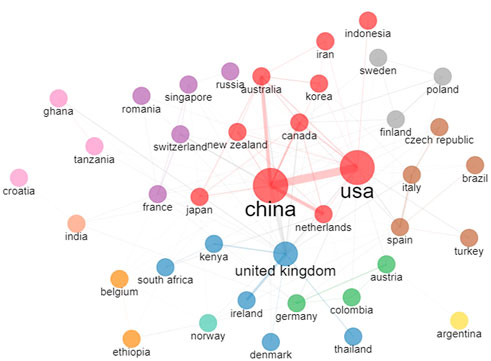
FIGURE 7. National collaborative network for research on rural settlements. Note: The size of the circle represents the number of articles published in cooperation with other countries, and the thickness of the connecting line represents the number of cooperation between countries; the thicker the line, the closer the connection between countries.
3.4 Keyword analysis
3.4.1 High-frequency keywords
Keywords provide the most simple and clear expression of the core content of an article. Analyzing the frequency of keywords in a certain field can therefore help summarizing the themes and hotspots of research in this field. We statistically analyzed the keywords in the field of rural settlements and generated the word cloud map of keywords. “Immigration,” “urbanization,” and “land use” were the keywords that most frequently appeared (Figure 8), accounting for 13%, 12%, and 7% of the total keywords, respectively. The keyword “China” accounted for 5% of the keywords, indicating that a large part of research was performed in this country. This corresponded to the number of articles analyzed above and the status of international cooperation in China. The frequencies of the keywords “policy” and “management” were also high, indicating that rural residential research was highly related to policy factors. At the same time, the research results on the evolution and simulation of rural settlements were linked to policies. For example, Yang et al. (2016) studied the spatial distribution characteristics and optimization analysis of rural settlements against the policy background of China’s rapid urbanization. Tu et al. (2018) took Huang Shandian Village in Beijing as an example and studied the adjustment of the village-level rural structure under the rapid urbanization in the metropolitan suburbs of China.
The most frequently found keyword in rural settlement studies was “migration,” which showed that population flow was one of most important reasons for the changes in rural settlements. For example, Chen et al. (2014) analyzed the impact of China’s rural population emigration on the transformation of rural settlement land, stating that the large-scale population flow between different regions led to the transformation of land use. Future studies on the impact of rural emigration on rural settlement areas should therefore take a multi-scale perspective (Chen et al., 2014). The research focus of each country will vary over time. For example, rural areas in the United States are mainly family farms, and the trend of agricultural specialization and intensive production is obvious. Therefore, keywords such as “Landscape” and “Life countryside” appeared frequently in relevant studies. “Land Use” and “Land Consolidation” have received a high degree of attention in studies of rural settlements in China. Although the word “Rural Hollowing” did not appear frequently, the hollowing and abandonment of rural settlements in China has attracted great attention. “Urbanization” appeared frequently in studies from almost all countries. Germany, Great Britain, and other European countries started their research on rural settlements early, and almost all developed countries carried out rural settlement renovation. Therefore, the rural development models of these countries have reference significance for countries with low rural development levels.
3.4.2 Cluster analysis of high-frequency keywords
Cluster analysis, also known as group analysis and point group analysis, is a multivariate statistical method for studying classification. Cluster analysis in bibliometry is based on the simultaneous frequency of two or two keywords, using statistical methods to reduce complex keyword grid relationships to several relatively small class groups; it first appeared in the 1960s (Blasius et al., 2009). This analysis type is an exploratory approach to graphically represent the associations among variables in large taxonomic datasets, with the aim to explore their relationships. In this study, the keywords with the highest similarities were merged into one cluster, and the clustering results of multiple corresponding analyses in the field of rural residential areas were divided into four categories (Figure 9):
(1) The first category was mainly related to geography, space, place, policy, and community. Studies in this category mainly investigated the spatial and temporal differences as well as the influencing factors and policy recommendations of rural settlement distribution in the field of geography (Song and Li, 2020). For example, Song and Li (2020) studied the spatial pattern evolution of rural residential areas in Tongzhou District, China, from 1961 to 2030, based on remote sensing image data; four evolution patterns of rural settlements in different periods were analyzed. Based on actual survey data, Qu et al. (2017) used spatial auto-correlation and spatial econometric models to quantitatively characterize the spatial differentiation and multifunctional structure of rural settlements, revealing the formation mechanism of rural multi-functionality.
(2) The second cluster was mainly related to urbanization, land management, land use transformation, and poverty. “China” and the “United States” also appeared as cluster keywords, indicating that these two countries played an important role in relevant research. Urbanization has a great impact on rural residential areas, and Liu et al. (2017b) discussed the dynamic spatio-temporal characteristics and trends of urban expansion in relation to the erosion of cultivated land and rural settlements. Understanding the changes in rural settlements due to radiation exposure during urbanization could help governments formulate relevant rural development policies.
(3) The third cluster was related to the improvement of rural settlements and urbanization-induced changes in settlements, focusing on the migration of the rural population to cities and towns. For example, Tas and Lightfoot (2005) reported that most urban growth in Turkey was shaped by rural-to-urban migration. Research on the improvement of rural settlements was mainly performed in China, emphasizing the changes in rural settlements caused by the number of rural settlements, the adjustment of their layout, the adjustment of land use scale and internal structure, and conducted comprehensive research on the potential, mode, planning, and evaluation of rural settlements.
(4) The fourth category mainly involved relocation willingness, population mobility, and rural population employment. As the integration and extinction of rural settlements, caused by urbanization, greatly impacted the production level and lifestyle of the rural population, various social problems have also been widely investigated. For example, Chai and Choi (2017) studied the trend of rural-oriented (migration/mobility) population migration and mobility in the context of rural reconstruction in Turkey. Xie and Chen (2018) analyzed China’s housing conditions, housing support, and migrant workers’ urban settlement intentions and found that rural migrants with better living conditions and housing support were more inclined to settle in cities. Although urban villages provide cheap housing for workers moving from rural areas, because of various urban problems, some authors proposed policy suggestions to encourage migrant workers to relocate from the perspective of sustainable urban development in China (Chai and Choi, 2017).
3.5 Analysis of the theme evolution in rural settlements
It is important to study the research development in a field from the perspective of themes and theme evolution (Weismayer and Pezenka, 2017). The Sankey chart, also known as the Sankey energy shunt, is a specific type of flow chart and can describe the flow of different nodes in the network; it is commonly used to analyze energy or matter flow. Arrows or direction lines indicate these flows, and their thickness is proportional to the flow size. The width of the extended branches in the figure corresponds to the extent of the data flow. This approach is mostly used in industrial ecology to assess the life cycle of a product and to determine the energy efficiency in engineering (Schmidt, 2008). Because of its broad utility, it has been applied in numerous geographic or environmental studies (Riehmann et al., 2005). Based on the Sankey diagram, we visually present the changes of themes in the research field of rural settlements over time. Referring to Chemchieva (2021), we divided the main transfer of rural settlement development into three stages, with 2000 and 2010 as breakpoints.
Rural settlement-related research topics changed over time (Figure 10). Before 2000, rural residential research was in the initial stage, and scientists started to explore the growth of residential areas and migration from the perspective of geography. During this period, the United Kingdom paid the most attention to rural residential research. From 2000 to 2010, the research scope gradually increased, studies focused on urban “population, land use change, community, and system, with a trend toward multidisciplinary and multi-perspective comprehensive analysis. Rural residential research from 2011 to 2020 mainly focused on land use change, urbanization, immigration, and policy. For example, Yang et al. (2016) pointed out that the optimization and reconstruction of rural residential space against the background of rapid urbanization was the key of rural sustainable development. Abubakari et al, 2016. stated that rural settlements need to formulate distinctive development plans based on regional characteristics, and rural land consolidation plays an important role in the study of rural settlements. Tu et al. (2018), using the example of Huangdian Village of Beijing, studied the gradual functional evolution of rural areas in the suburbs of metropolises. Through optimizing the allocation of land resources to promote the adjustment of the rural structure in metropolitan suburbs, suggestions were made for the innovation of land use policies and systems (Tu et al., 2018).
4 Discussion
4.1 Research trend
Rural settlements are the geospatial carriers of agricultural production, farmers’ income and activities, and the rural ecosystem and at the core of the relationship between the rural population and the land. Based on previous studies of rural settlements, we found that rural settlement studies were mostly qualitative analyses of landscape descriptions in the initial period, and few studies began to focus on the planned changes of the reduction of rural settlements and population (Palmer, 1988). After 2000, rural settlements attracted an increase attention from the scientific community, and data acquisition and visual analysis methods were enriched with the wide application of the 3S technology (Remote sensing, Geography information systems, Global positioning systems). Important results were obtained in the research on the evolution law, influencing factors, spatial distribution patterns, and optimal layouts of rural settlements (Cao et al., 2017; Kong et al., 2021). In recent years, research on rural settlements has reached a multi-perspective and interdisciplinary level, with a rich research perspective.
4.2 Prospects
At present, research in the area of rural settlements is highly diverse. Future studies should focus on the investigation of rural settlements from the interdisciplinary perspective and enhance the cooperation among countries to include different perspectives. Since rural residential area renovation and rural revitalization have become hot issues, research on the interaction between rural settlement land change and nature, society, and economy is extensive. However, authors are encouraged to focus on the analysis of driving factors, such as the driving factors of rural “hollowing out,” the relocation of rural collective migrants, and the rural ecosystem. As a basic social unit in rural areas, farmers are the main factors to consider in studies of rural residential area renovation, emphasizing on their ethnic customs, consumption habits, religious beliefs, original economic basis, and policy factors. In this context, the importance of rural settlement development for the diversity of human needs will gradually increase. Future studies should therefore focus on the exploration of spatio-temporal evolution mechanisms and trend prediction, supported by GIS technology. Based on strengthening theoretical practice, the analysis of the evolution pattern of rural settlements, the summary of different evolution models, and the analysis of influencing factors are crucial, with the aim to generate an extensive and systematic research system.
4.3 Comparison with previous studies
At present, the research perspective of rural settlements is multi-dimensional, with considerable achievements. Based on the results discussed here, most articles are based on a specific aspect; for example, from the perspective of specific disciplines (Phillips et al., 2008), specific research areas (Janusek and Kolata, 2004), and the development of major thought lines (Drobnjaković et al., 2017). Based on these studies, we can indeed understand the specific situation of rural settlements under a certain perspective, but it is difficult to establish a unified logical main line between different research perspectives. The systematic characteristics of the research field have been largely ignored, which impedes a comprehensive understanding of the overall research situation from a macro-perspective. Using the Web of Science database, which contains articles covering natural science, engineering technology, social science, and many other fields, we synchronously analyzed the existing literature based on results, authors, institutions, hotspots, and other perspectives. Through visual data analysis, we stereoscopically present information, avoiding information loss caused by the segmentation of the research angle and incoherent research processes, which are common in traditional literature research.
5 Conclusion
Based on the Web of Science database, we retrieved articles in the field of rural settlements published from 1973 to 2021 and used the Bibliometrix software to analyze them, obtaining the following conclusion:
(1) According to the annual output of articles, the development of rural settlement research could be divided into the initial stage (1973–1990), developmental stage (1991–201), and high-yield stage (2011–2021).
(2) Most of the articles in this field were published in Asia, Europe, and Africa. Countries with more than 100 articles published were China, the United States, the United Kingdom, Australia, Brazil, Canada, and Spain. China, which published the largest number of articles (699), was also the center of international cooperation in the field of rural settlement research, mostly together with the United States.
(3) High-frequency keywords in rural residential research were “Immigration,” “Urbanization,” “Land use,” and “Population flow.” Cluster analysis revealed four clusters: one related to geography, space, place, policy, and community, one related to land management, land use transformation, and urbanization, one focusing on rural residential area renovation and residential settlement changes due to urbanization, and one related to residential intention, population flow, and employment of the rural population.
Based on our results, we encourage scientists to include the evolution of the spatiotemporal pattern of rural settlements, the transformation of rural land use, and the relationship between rural settlement changes and rural population in their studies.
Author contributions
JL and WS: Methodology, software, validation, writing. JL: Software, investigation, validation, data curation, writing-originaldraft. WS: Methodology, validation, project administration, writing-review and editing. All authors contributed to the article and approved the submitted version.
Funding
This research was supported by the Second Tibetan Plateau Scientific Expedition and Research (grant number 2019QZKK0603) and the Projects of National Natural Science Foundation of China (grant number 42071233 and 41671177).
Acknowledgments
The authors thank the native English-speaking experts from the editing team for polishing our paper.
Conflict of interest
The authors declare that the research was conducted in the absence of any commercial or financial relationships that could be construed as a potential conflict of interest.
Publisher’s note
All claims expressed in this article are solely those of the authors and do not necessarily represent those of their affiliated organizations, or those of the publisher, the editors and the reviewers. Any product that may be evaluated in this article, or claim that may be made by its manufacturer, is not guaranteed or endorsed by the publisher.
References
Abubakari, Z., Van der Molen, P., Bennett, R., and Kuusaana, E. D. (2016). Land consolidation, customary lands, and Ghana's Northern Savannah Ecological Zone: An evaluation of the possibilities and pitfalls. Land use policy 54, 386–398.
Aria, M., and Cuccurullo, C. (2017). Bibliometrix : An R-tool for comprehensive science mapping analysis. J. Inf. 11, 959–975. doi:10.1016/j.joi.2017.08.007
Bibby, P. (2009). Land use change in Britain. Land Use Policy 26, S2–S13. doi:10.1016/j.landusepol.2009.09.019
Bittner, C., and Sofer, M. (2013). Land use changes in the rural–urban fringe: An Israeli case study. Land Use Policy 33, 11–19. doi:10.1016/j.landusepol.2012.11.013
Blasius, J., Greenacre, M., Groenen, P. J., and van de Velden, M. (2009). Special issue on correspondence analysis and related methods. Comput. Statistics Data Analysis 53, 3103–3106. doi:10.1016/j.csda.2008.11.010
Brady, S. J., and Flather, C. H. (1994). Changes in wetlands on nonfederal rural land of the conterminous United States from 1982 to 1987. Environ. Manag. 18, 693–705. doi:10.1007/bf02394634
Cao, Y., Bai, Z., Sun, Q., and Zhou, W. (2017). Rural settlement changes in compound land use areas: Characteristics and reasons of changes in a mixed mining-rural-settlement area in Shanxi Province, China. Habitat Int. 61, 9–21. doi:10.1016/j.habitatint.2017.01.002
Chai, N., and Choi, M. J. (2017). Migrant workers’ choices of resettlements in the redevelopment of urban villages in China: The case of Beijing. Int. J. Urban Sci. 21, 282–299. doi:10.1080/12265934.2017.1290542
Chemchieva, A. (2021). Urbanization processes in the indigenous population of the altai republic: Stages, factors, prospects. A Q. J. Russ. Engl. 49, 126119–126126. doi:10.17746/1563-0110.2021.49.3.119-126
Chen, R., Ye, C., Cai, Y., Xing, X., and Chen, Q. (2014). The impact of rural out-migration on land use transition in China: Past, present and trend. Land use policy 40, 101–110. doi:10.1016/j.landusepol.2013.10.003
Deng, X., Jin, G., He, S., Wang, C., Li, Z., Wang, Z., et al. (2021). Research progress and prospect on development geography. J. Geogr. Sci. 31, 437–455. doi:10.1007/s11442-021-1852-x
Dong, X., and Xu, S. (2020). Spatial evolution characteristics of urban and rural settlements in Inner Mongolia. Arabian J. Geosciences 13, 1214–1311. doi:10.1007/s12517-020-06167-z
Drobnjaković, M., Vuksanović-Macura, Z., Spalević, A., and Todorić, J. (2017). Researching and planning the rural space: The work of branislav kojić. J. Geogr. Institute" Jovan Cvijic" SASA 67, 195–211. doi:10.2298/ijgi1702195d
Du, J., and King, C. (2018). Unravelling China's food security puzzle, 1979–2008. China Q. 235, 804–827. doi:10.1017/s0305741018000917
Guo, B., Bian, Y., Pei, L., Zhu, X., Zhang, D., Zhang, W., et al. (2022). Identifying population hollowing out regions and their dynamic characteristics across central China. Sustainability 14, 9815. doi:10.3390/su14169815
Guo, P., Zhang, F., Wang, H., and Qin, F. (2020). Suitability evaluation and layout optimization of the spatial distribution of rural residential areas. Sustainability 12, 2409. doi:10.3390/su12062409
Hao, P., and Tang, S. (2015). Floating or settling down: The effect of rural landholdings on the settlement intention of rural migrants in urban China. Environ. Plan. A 47, 1979–1999. doi:10.1177/0308518x15597131
Hingley, R. (2004). Rural settlement in northern Britain. London: A companion to Roman Britain, 327–348.
Huang, Q., Song, W., and Song, C. (2020). Consolidating the layout of rural settlements using system dynamics and the multi-agent system. J. Clean. Prod. 274, 123150. doi:10.1016/j.jclepro.2020.123150
Janusek, J. W., and Kolata, A. L. (2004). Top-down or bottom-up: Rural settlement and raised field agriculture in the lake titicaca basin, Bolivia. J. Anthropol. Archaeol. 23, 404–430. doi:10.1016/j.jaa.2004.08.001
Jiang, G., Chen, T., Zhang, R., Tian, Y., and Wu, S. (2022). A spatial patterns identification method of rural residential land change integrating dynamic and multi-scale information. Front. Environ. Sci. 10, 585. doi:10.3389/fenvs.2022.902556
Kiss, E. (2000). Rural restructuring in Hungary in the period of socio-economic transition. GeoJournal 51, 221–233. doi:10.1023/a:1017507328301
Kohler, F., Marchand, G., and Negrão, M. (2015). Local history and landscape dynamics: A comparative study in rural Brazil and rural France. Land Use Policy 43, 149–160. doi:10.1016/j.landusepol.2014.11.010
Kong, X., Liu, D., Tian, Y., and Liu, Y. (2021). Multi-objective spatial reconstruction of rural settlements considering intervillage social connections. J. Rural Stud. 84, 254–264. doi:10.1016/j.jrurstud.2019.02.028
Lewis, C. A., and Mrara, A. (1986). Rural settlements, mission settlements and rehabilitation in Transkei. Geojournal 12, 375–386. doi:10.1007/bf00262360
Li, G., and Hu, W. (2019). A network-based approach for landscape integration of traditional settlements: A case study in the wuling mountain area, southwestern China. Land Use Policy 83, 105–112. doi:10.1016/j.landusepol.2019.01.043
Li, H., and Song, W. (2020). Evolution of rural settlements in the Tongzhou District of Beijing under the new-type urbanization policies. Habitat Int. 101, 102198. doi:10.1016/j.habitatint.2020.102198
Li, J., Lo, K., Zhang, P., and Guo, M. (2021). Reclaiming small to fill large: A novel approach to rural residential land consolidation in China. Land Use Policy 109, 105706. doi:10.1016/j.landusepol.2021.105706
Liu, Y., He, S., Wu, F., and Webster, C. (2010). Urban villages under China's rapid urbanization: Unregulated assets and transitional neighbourhoods. Habitat Int. 34, 135–144. doi:10.1016/j.habitatint.2009.08.003
Liu, Y., Yang, Y., Li, Y., and Li, J. (2017). Conversion from rural settlements and arable land under rapid urbanization in Beijing during 1985–2010. J. Rural Stud. 51, 141–150. doi:10.1016/j.jrurstud.2017.02.008
Liu, Z., Wang, Y., and Chen, S. (2017). Does formal housing encourage settlement intention of rural migrants in Chinese cities? A structural equation model analysis. Urban Stud. 54, 1834–1850. doi:10.1177/0042098016634979
Long, H., Qu, Y., Tu, S., Zhang, Y., and Jiang, Y. (2020). Development of land use transitions research in China. J. Geogr. Sci. 30, 1195–1214. doi:10.1007/s11442-020-1777-9
Mann, S. (2009). Institutional causes of urban and rural sprawl in Switzerland. Land use policy 26, 919–924. doi:10.1016/j.landusepol.2008.11.004
McManus, P., Walmsley, J., Argent, N., Baum, S., Bourke, L., Martin, J., et al. (2012). Rural Community and Rural Resilience: What is important to farmers in keeping their country towns alive?. Journal of Rural Studies 28, 20–29.
Nepal, S. K. (2007). Tourism and rural settlements Nepal’s Annapurna region. Ann. Tour. Res. 34, 855–875. doi:10.1016/j.annals.2007.03.012
Palmer, E. (1988). Planned relocation of severely depopulated rural settlements: A case study from Japan. J. Rural Stud. 4, 21–34. doi:10.1016/0743-0167(88)90076-9
Phillips, M., Page, S., Saratsi, E., Tansey, K., and Moore, K. (2008). Diversity, scale and green landscapes in the gentrification process: Traversing ecological and social science perspectives. Appl. Geogr. 28, 54–76. doi:10.1016/j.apgeog.2007.07.003
Phillips, M. (1998). The restructuring of social imaginations in rural geography. J. Rural Stud. 14, 121–153. doi:10.1016/s0743-0167(97)00056-9
Qu, Y., Jiang, G. H., Li, Z., Tian, Y., and Wei, S. (2019). Understanding rural land use transition and regional consolidation implications in China. Land Use Policy 82, 742–753. doi:10.1016/j.landusepol.2018.11.014
Qu, Y., Jiang, G., Zhao, Q., Ma, W., Zhang, R., and Yang, Y. (2017). Geographic identification, spatial differentiation, and formation mechanism of multifunction of rural settlements: A case study of 804 typical villages in shandong province, China. J. Clean. Prod. 166, 1202–1215. doi:10.1016/j.jclepro.2017.08.120
Riehmann, P., Hanfler, M., and Froehlich, B. (2005). “Interactive sankey diagrams,” in Proceedings of IEEE symposium on information visualization (Minnesota: INFOVIS), 233–240.
Salvati, L., Munafo, M., Morelli, V. G., and Sabbi, A. (2012). Low-density settlements and land use changes in a Mediterranean urban region. Landsc. Urban Plan. 105, 43–52. doi:10.1016/j.landurbplan.2011.11.020
Schmidt, M. (2008). The sankey diagram in energy and material flow management: Part II: Methodology and current applications. J. industrial Ecol. 12, 173–185. doi:10.1111/j.1530-9290.2008.00015.x
Sevenant, M., and Antrop, M. (2007). Settlement models, land use and visibility in rural landscapes: Two case studies in Greece. Landsc. urban Plan. 80, 362–374. doi:10.1016/j.landurbplan.2006.09.004
Shi, Z., Ma, L., Zhang, W., and Gong, M. (2022). Differentiation and correlation of spatial pattern and multifunction in rural settlements considering topographic gradients: Evidence from Loess Hilly Region, China. J. Environ. Manag. 315, 115127. doi:10.1016/j.jenvman.2022.115127
Song, W., and Deng, X. (2017). Land-use/land-cover change and ecosystem service provision in China. Sci. Total Environ. 576, 705–719. doi:10.1016/j.scitotenv.2016.07.078
Song, W., and Li, H. (2020). Spatial pattern evolution of rural settlements from 1961 to 2030 in Tongzhou District, China. Land Use Policy 99, 105044. doi:10.1016/j.landusepol.2020.105044
Song, W., and Pijanowski, B. C. (2014). The effects of China's cultivated land balance program on potential land productivity at a national scale. Appl. Geogr. 46, 158–170. doi:10.1016/j.apgeog.2013.11.009
Song, Y., Zenou, Y., and Ding, C. (2008). Let's not throw the baby out with the bath water: The role of urban villages in housing rural migrants in China. Urban Stud. 45, 313–330. doi:10.1177/0042098007085965
Sun, D., Hong, B., and Ren, P. (2022). Spatiotemporal evolution and driving factors of the rural settlements in the mountain–plain transitional zone. Int. J. Agric. Biol. Eng. 15, 149–155. doi:10.25165/j.ijabe.20221502.5776
Sun, H., Liu, Y., and Xu, K. (2011). Hollow villages and rural restructuring in major rural regions of China: A case study of yucheng city, shandong province. Chin. Geogr. Sci. 21, 354–363. doi:10.1007/s11769-011-0474-0
Tan, M., and Li, X. (2013). The changing settlements in rural areas under urban pressure in China: Patterns, driving forces and policy implications. Landsc. Urban Plan. 120, 170–177. doi:10.1016/j.landurbplan.2013.08.016
Tang, S., and Feng, J. (2015). Cohort differences in the urban settlement intentions of rural migrants: A case study in jiangsu province, China. Habitat Int. 49, 357–365. doi:10.1016/j.habitatint.2015.06.009
Tas, H. I., and Lightfoot, D. R. (2005). Gecekondu settlements in Turkey: Rural—Urban migration in the developing European periphery. J. Geogr. 104, 263–271. doi:10.1080/00221340508978648
Thorsen, I., and Ubøe, J. (2002). Modelling residential location choice in an area with spatial barriers. Ann. regional Sci. 36, 613–644. doi:10.1007/s001680200094
Tu, S., Long, H., Zhang, Y., Ge, D., and Qu, Y. (2018). Rural restructuring at village level under rapid urbanization in metropolitan suburbs of China and its implications for innovations in land use policy. Habitat Int. 77, 143–152. doi:10.1016/j.habitatint.2017.12.001
Wang, J., and Fang, C. (2011). Growth of urban construction land:progress and prospect. Prog. Geogr.
Weismayer, C., and Pezenka, I. (2017). Identifying emerging research fields: A longitudinal latent semantic keyword analysis. Scientometrics 113, 1757–1785. doi:10.1007/s11192-017-2555-z
Whatmore, S. (1993). Sustainable rural geographies? Prog. Hum. Geogr. 17, 538–547. doi:10.1177/030913259301700408
Yang, R., Xu, Q., and Long, H. (2016). Spatial distribution characteristics and optimized reconstruction analysis of China’s rural settlements during the process of rapid urbanization. J. rural Stud. 47, 413–424. doi:10.1016/j.jrurstud.2016.05.013
Keywords: rural settlements, bibliometrics, bibliometrix, theme evolution, rural land renovation
Citation: Li J and Song W (2023) Review of rural settlement research based on bibliometric analysis. Front. Environ. Sci. 10:1089438. doi: 10.3389/fenvs.2022.1089438
Received: 04 November 2022; Accepted: 16 December 2022;
Published: 04 January 2023.
Edited by:
Xiaowei Chuai, Nanjing University, ChinaReviewed by:
Qunou Jiang, Beijing Forestry University, ChinaJianjun Zhang, China University of Geosciences, China
Copyright © 2023 Li and Song. This is an open-access article distributed under the terms of the Creative Commons Attribution License (CC BY). The use, distribution or reproduction in other forums is permitted, provided the original author(s) and the copyright owner(s) are credited and that the original publication in this journal is cited, in accordance with accepted academic practice. No use, distribution or reproduction is permitted which does not comply with these terms.
*Correspondence: Wei Song, c29uZ3dAaWdzbnJyLmFjLmNu
 Junfang Li
Junfang Li Wei Song
Wei Song